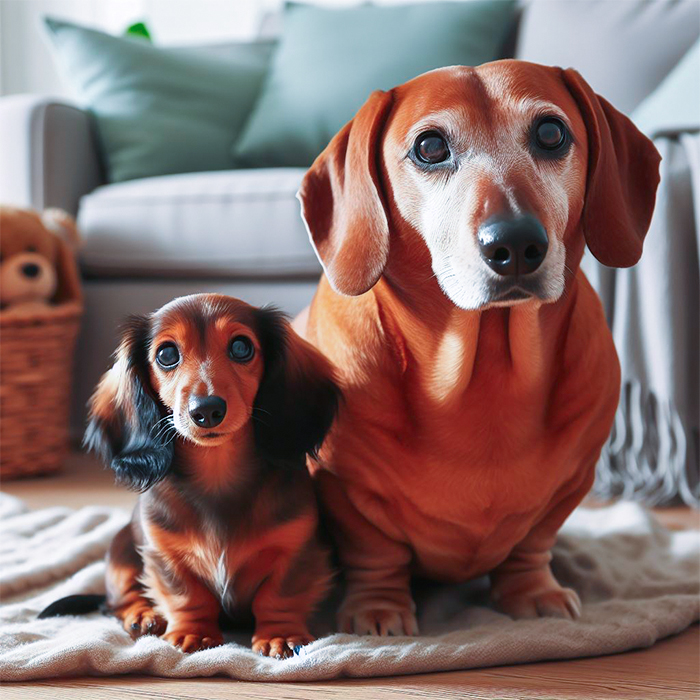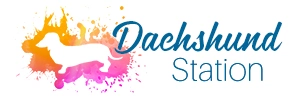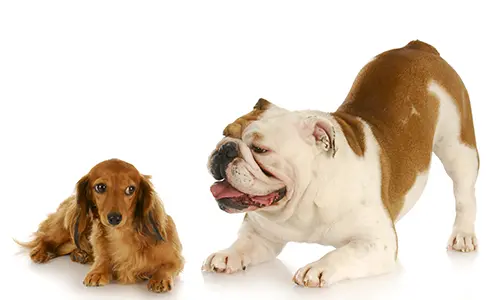
7 Easy Ways to Introduce a New Puppy to an Older Dog
Bringing a new puppy home can be an incredibly fun and exciting journey for you and your family. However, introducing a new puppy to the current dog of the household can trigger stress, jealousy, and anxiety if not properly introduced.
My family and I made the big decision to adopt a new dachshund puppy this summer. The biggest challenge we encountered was introducing him to our 14-year-old dog, Bastian.
Through a lot of trial and error, our older dog and puppy are finally getting along. Read on to learn How To Introduce A New Puppy To An Older Dog.

When my husband and I were first married many years ago, we adopted three dogs all within the same year. Yeah, we went a little fur -baby crazy! We had Bastian (beagle/dachshund mix), Reno (mini dachshund), and Artemus (German shepherd). They were all around the same age and they got along great.
Fourteen years down the line, Bastian, now a senior, stands as the last remaining member of our original canine pack.
Getting him acquainted with our new puppy was a bit of a process, but totally manageable.
How Do You Get An Older Dog to Accept A New Puppy?
As you introduce your new puppy to the older dog, it is important to do the following to help maintain a happy and safe home for both dogs.
1. Neutral Location
When we brought our new Dachshund puppy, Eko, home we introduced him to Bastian in our front yard first before bringing him into the house.
Introduce your older dog to the new puppy at a neutral location, not inside your home right away. This can be in your yard or at a park.
Out of respect for Bastian, we needed a friendly meeting between the two dogs before inviting our new furry family member inside. Our home is Bastian’s den after all.
Designated Area For Puppy:
Your new pup should have their own crate and puppy play area gated off from the house and from your older dog. Puppies need to stay in a designated area during their puppy potty training to keep them from getting into trouble or bothering other pets in the home.

2. Playtime:
Over the next couple of weeks, we allowed Eko to have brief visits with Bastian throughout the day. The puppy was not allowed to roam the house yet, so the visits were always within a small, gated area. If Bastian wanted to escape the puppy playfulness, we allowed him to leave the room.
Supervision: All play time sessions with both dogs were fully supervised just in case they needed to be separated.
Toys: Have some toys and treats available to help the play session feel fun for both dogs.
Sniffing: Allow both dogs to sniff each other. Keep it brief and positive.
Playtime doesn’t always go well: Little Eko loves to jump up and bite Bastian because that is how he plays. Unfortunately, Bastian would rather not play that way, so playtime often falls on our shoulders to tire all that puppy energy out each day.
Dogs Need Their Own Things:
Both dogs should have their own dog bowls, beds, blankies, and toys. Your older dog cherishes their own items, so don’t allow the puppy to move in and take over their stuff.
3. Food:
Separate the dogs into different areas of the house during mealtime. Puppies have a special diet formulated for their system and senior dogs have a special diet as well. If the dogs try to eat each other’s food, they could get upset tummies.
Dogs can be very territorial when it comes to their food, bones, and treats.
Don’t allow the new puppy near your older dog during meal time, to avoid a fight. Bastian and Eko love to play games with me and try to gobble up each other’s food when I’m not looking. So, we always have them eat in separate rooms.
When the puppy turns 1, we will be switching him to an adult dog food. Bastian will still be on senior dog food, so they will need to continue to stay separate during mealtime.
Post You May Like: How To Switch Your Puppy To Adult Dog Food

4. Training Sessions:
While I teach Eko new training commands, Bastian often wants to join in because he loves the training time treats too.
I conduct training sessions both with Bastian and Eko together, as well as separate individual sessions. They both enjoy the delicious tuna, chicken, or salmon-based treats provided during their training.
The MOST rewarding aspect is that during the training sessions, the dogs get along remarkably well!
Both of them direct their attention towards me and the special dog treats, rather than bothering each other.
Walking:
Take your dogs for walks both together and separately. Eko is only 11 weeks old, so he is still adjusting to walking with a leash and a dog harness. He doesn’t walk far before sitting down and refusing to move, which is typical for a new pup.
Even brief walks at this age are beneficial in helping the puppy become socialized, active and healthy.
Bastian enjoys walking for about 20 minutes. Therefore, when we walk the dogs together, we usually bring a dog backpack to help carry Eko when he needs a break.
5. Socializing
Unfortunately, Bastian wasn’t socialized as a young puppy. From the start, Bastian had his den mates, our dachshund Reno, and our German Shepherd, Artemus to play with.
They were his doggie family. We didn’t reach out and meet other people with dogs because they were so good with each other at home.
We didn’t know how crucial it really was for us to take them out and meet other dogs that didn’t live with us.
Lesson learned! Eko is now starting his socialization training at 11 weeks old. We are gradually introducing him to new friends and family members. Even though he has Bastian at home, he needs to go out and play with other dogs to prevent future socialization issues.
Our vet recommended that we stay away from public dog parks and pet stores until Eko has all of his necessary puppy vaccines, around 16 weeks old. Our puppy playdates are usually with friends who have small dogs (Eko’s size) and are vaccinated.
Post You May Like: How To Socialize Your Puppy
6. One-On-One Personal Time
It is important to make one-on-one time with both dogs individually. Separate play sessions and walks can help your dog feel special and loved.
Since the new puppy arrived, I make sure to take individual walks with just Bastian. When I let Bastian outside to go potty, I make sure to give him big hugs and kisses. I know he appreciates it because he reacts with a big tail wag.
I need to always let him know that he is still my dog and I love him the same, even with a new puppy in the house.
7. Keep Routines
It is important to maintain the same routines with your current dog when you bring home a new puppy. If you change anything up, it can upset your older dog, causing them stress and anxiety.
Do Dogs Get Jealous Of New Puppies?
Yes, I believe, just like a young child being introduced to a new baby, dogs do get jealous of the new addition. Bastian is a very easy-going older dog. He is 14 years old, he loves to go for walks, but he also loves to take plenty of quiet naps throughout the day.
Now that the puppy is here, Bastian always wants to be in the room with me and the puppy, or at least close by. I make sure not to give the new puppy all of my attention.
I don’t want Bastian to become angry or territorial towards me or the new pup.

How To Prevent Dog Fights:
Eko and Bastian still have their “mean moments” when they are in the same room together. Sometimes Eko slips away from us and darts right for Bastian’s bed and pounces on top of him.
It is hilarious to watch, but very unfair to Bastian, so we try our best to stop that from happening. We try to keep them separated throughout the day and supervised when they are together.
Redirection: Re-direct your new puppy from your older dog when he gets too rambunctious.
Positive Interactions: Playtime needs to stay positive. Use new fun toys and yummy treats to keep them happy and occupied.
Brief Visits: Keep visits between your dogs brief and supervised.

Should I Let My Older Dog Growl At My Puppy?
Growling will happen. Dogs use this form of communication to let the other dog know their boundaries and comfort level. Of course, your older dog doesn’t want a crazy puppy biting and jumping in their face.
Your older dog may growl to let the puppy know he needs them to back off.
Always supervise when your dogs are exchanging barks, growls, or submissive behavior. Don’t allow your puppy and older dog to be left alone until you are very confident that they are safe around each other.
How Long Does It Take For A Dog To Get Used To A New Puppy?
Some gentle playtime between your older dog and the puppy will naturally begin anywhere between 4-8 weeks. Every dog is different, it may take a little longer for your older dog to adjust to the new pup.
Continue supervising brief play times when your dogs are together. They will begin to understand each other’s ways and eventually become happy housemates.
During this time of introduction, your dogs may have a couple of bad interactions with each other.
Bastian and Eko took about 3 months to get along with each other, needing less supervision. So, after that point, we didn’t need to keep them separate anymore.
Continue to keep things positive and be patient, dogs will adapt over time. If you continue to have trouble with your older dog and the new pup, consult your vet or consider trying some professional dog training to help them adjust.
What methods helped you introduce a new puppy to an older dog? Let us know in the comments below.
Helpful Links:
- Zak George on YouTube: Puppy and Older Dog Training
- Wag Walking: Accepting a New Puppy
- Form A Strong Bond With Your Dog by Dog House Times



Great post and would love to rescue another but cannot at this moment.
Thanks for sharing Ruth.
Fantastic post full of really useful information. I think that the separate time for each dog when you are a multi-dog household is particularly important.
Hi Melanie, Thanks so much for sharing. :) Yes, I agree, it is important.
I think this is a great post not only for a new puppy meeting an older dog, but two new dogs meeting in general. I remember when I first moved in with my boyfriend, our dogs did not get along. They definitely were jealous of each other (they still are sometimes!) even though they are both adult dogs around the same age. We slowly introduced them and made sure they still had their own beds and their own toys and all that. So, now, they get along just fine. Therefore, I think this post is great for all new dogs living together, and it is advice that people should definitely consider before bringing home a new dog.
Hi Molly, I’m glad your pups are now getting along well. So glad those methods worked for you guys. Thanks for sharing.